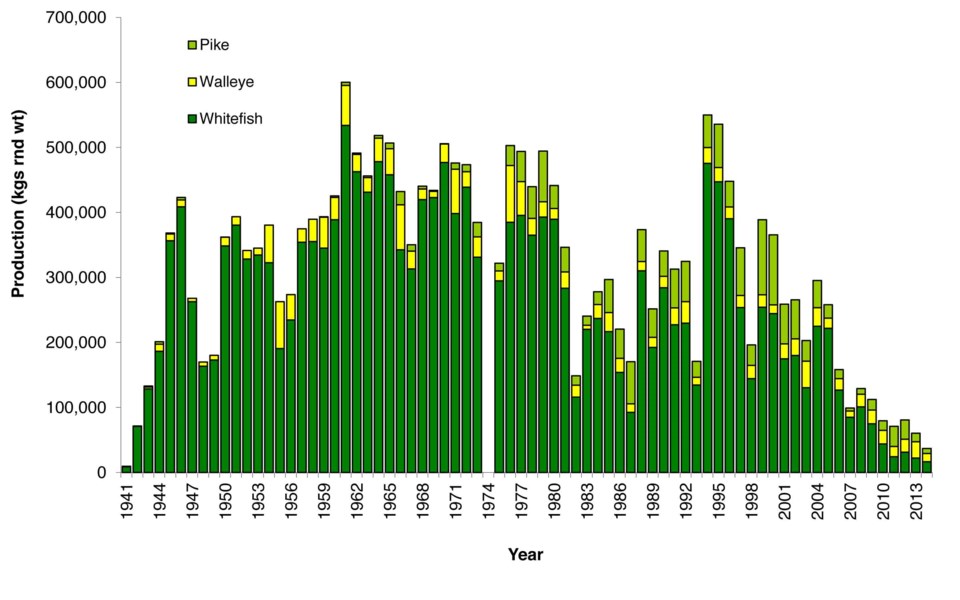Under the oversight and management of the province, the commercial whitefish harvest on South Indian Lake has declined by 90 per cent. What was once the second-largest whitefish fishery in Manitoba, and the lifeblood of our proud self-reliant community, is mostly gone. Most of this collapse happened since the NDP took power in 1999.
Despite that, neither the province nor Manitoba Hydro, which floods our lake well beyond the limits of its 1973 licence, are working with the fishers of South Indian Lake to address the situation.
Production was at 447,854 kg in 1996 and 388,734 kg in 1999. In 2014, it was less than a tenth of that, at 36,862 kg. The result is simple: hard-working fishers have been doomed to the welfare rolls. The losses to the local and provincial economy can be counted in the millions.
There were once 163 licensed commercial fishermen in South Indian Lake providing a good income for their families. In 2014, only 34 remained and they were lucky to break even.
The history of our community is one of proud, hard-working fishers. We had no reserve until 2005 and lived largely beyond the interference of Indian Affairs. A 1967 study found that household incomes in South Indian Lake were seven times higher than most northern aboriginal communities. Welfare was non-existent.
But the rug has been pulled out from under us with the collapse of our primary industry. We believe that flooding and severe water fluctuations caused by Hydro are the primary cause. Following the initial flooding in the ‘70s, our fishery rebounded in the late ‘80s and into the ‘90s. But due to lack of oversight and extreme Hydro operations since the mid-’90s, the fishery has been decimated.
Manitoba Hydro is licensed to operate the lake—the fourth-largest in Manitoba—within a three-foot range, with a drawdown of no more than two feet in any 12-month period. But for years, the province has annually granted Hydro permission to “deviate” from its licence by fluctuating the lake within a 4.5-foot range with no specific limitations on drawdowns. This is done with no regulatory oversight or community consultation.
From 2003 to 2013, Manitoba and Manitoba Hydro worked directly with our fishers’ association and other local groups that had signed agreements related to Hydro. It wasn’t perfect but we were headed in the right direction. But once scientific studies we mandated drew connections between fish decline and Hydro operations, the utility and the provincial fisheries branch walked away from the table without even notifying us.
A letter outlining our concerns was sent to Conservation and Water Stewardship Minister Tom Nevakshonoff on April 8 of last year. He has chosen not to deal with the issue.
In a press release about Manitoba fisheries last November, Nevakshonoff said, “for many years, high-quality fisheries have provided food, recreation and jobs for generations of people living near and visiting Manitoba’s lakes.” Why then is the government not even talking to us about how to restore that sort of vibrant fishery at South Indian Lake?
Speaking to an audience in Washington D.C. about the Keeyask project in 2013, Premier Greg Selinger said, “we’re going to be restoring the sturgeon fishery in Northern Manitoba.” He has never expressed the same desire to rebuild the South Indian Lake fish stocks.
We believe our fishery can be saved to a significant extent. But solutions will only come through meaningful discussion between Hydro, the province and local stakeholders. We believe those solutions would include follow-through on studies into fish decline and also compliance with Hydro’s operating licence. We’re not asking Hydro to pack up and leave, just that they stick to their actual licence, without deviations, and follow up on the work done by a highly credible scientist who they funded.
Hydro and government officials might respond by saying they recently released a 6,000-page Regional Cumulative Effects Assessment and that they have spent millions on compensation. But what they can’t say is that they are working with us to restore the fishery. The discussion should not be about dollar amounts but about a transparent process and about Hydro playing by the rules.
Our government talks about reconciliation and a bright future for all. We don’t see it.
In relation to flood prevention infrastructure in the south, Premier Selinger recently said, “a community underwater has no economy.” Good point. Flooding, water fluctuations and economic vitality do not go together. We are underwater and drowning. Change is needed. So perhaps some of the flood concern could be shifted to the north. Because, as the NDP like to say, “everyone matters.” Our future and youth need to matter.
Steve Ducharme is a long-time commercial fisherman and president of the South Indian Lake Fisherman’s Association.




